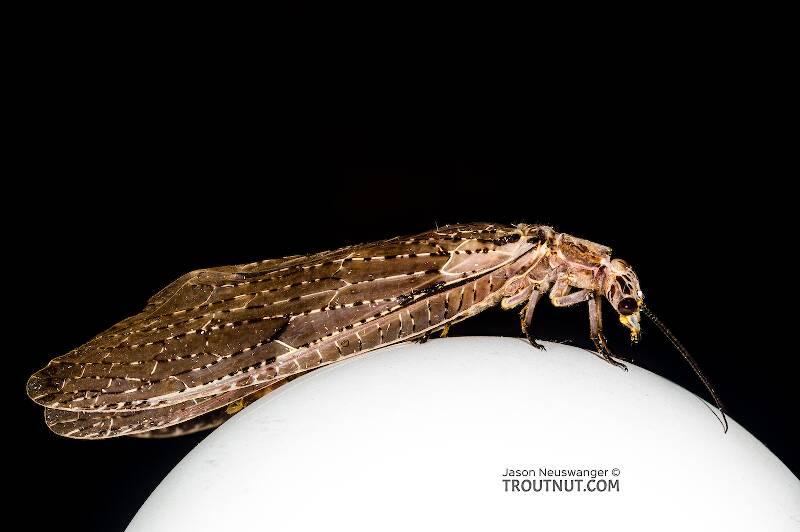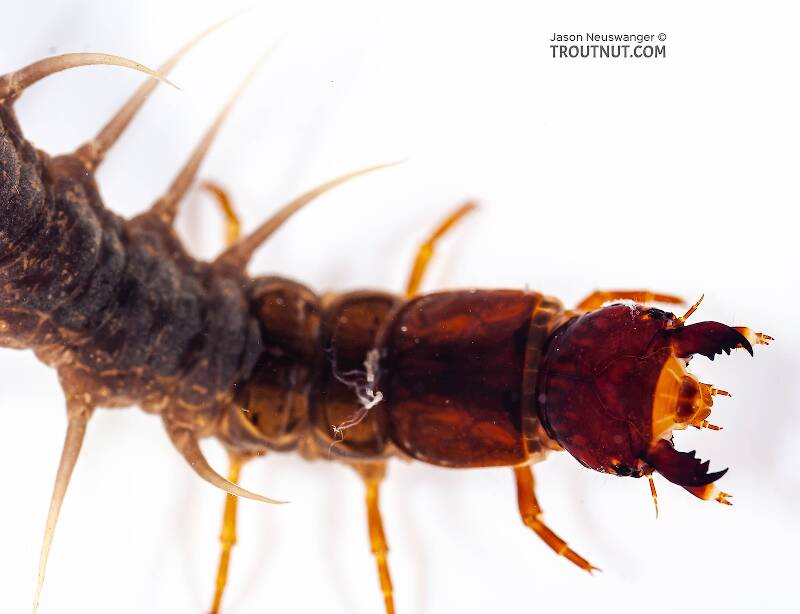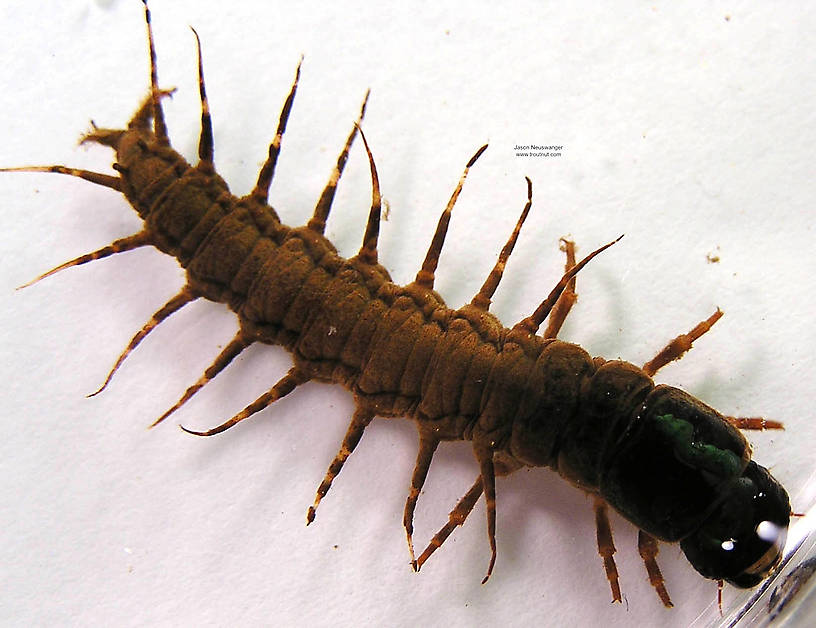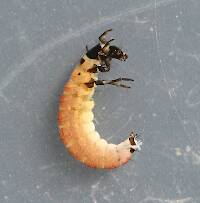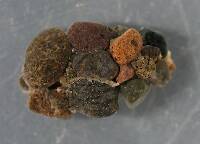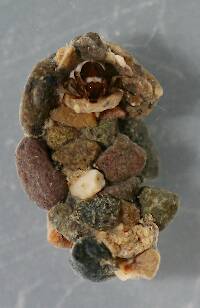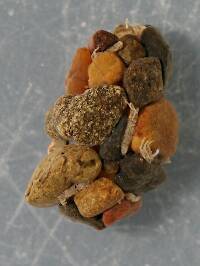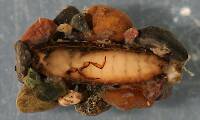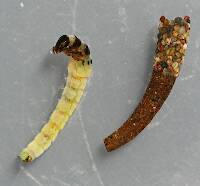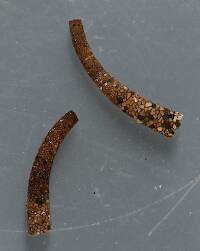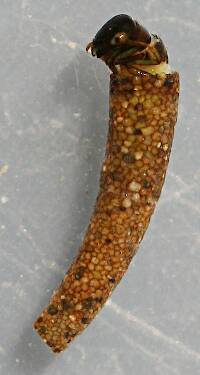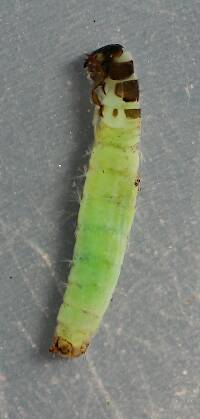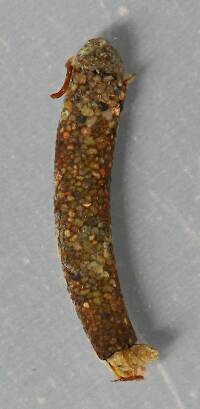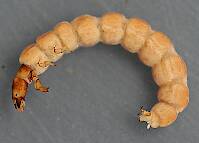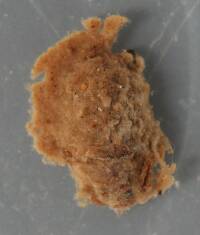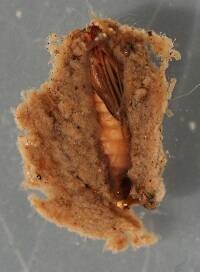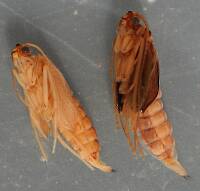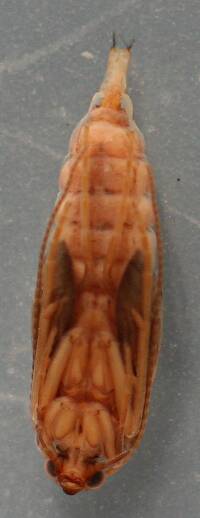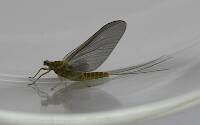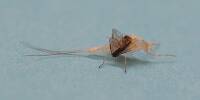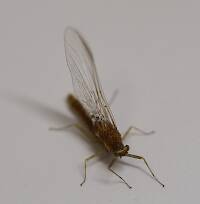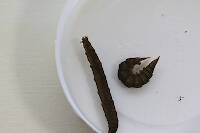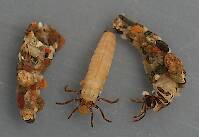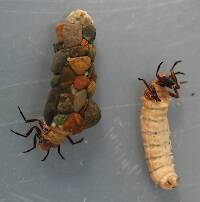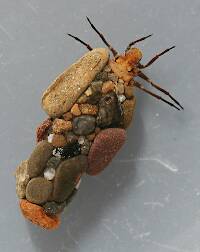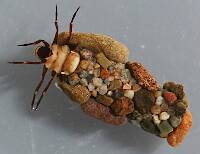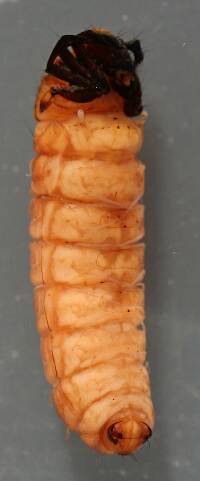
Salmonflies
Pteronarcys californica
The giant Salmonflies of the Western mountains are legendary for their proclivity to elicit consistent dry-fly action and ferocious strikes.
Featured on the forum

This one seems to lead to Couplet 35 of the Key to Genera of Perlodidae Nymphs and the genus Isoperla, but I'm skeptical that's correct based on the general look. I need to get it under the microscope to review several choices in the key, and it'll probably end up a different Perlodidae.

Troutnut is a project started in 2003 by salmonid ecologist Jason "Troutnut" Neuswanger to help anglers and
fly tyers unabashedly embrace the entomological side of the sport. Learn more about Troutnut or
support the project for an enhanced experience here.
This topic is about the Insect Family Corydalidae
Hellgrammites are the vicious larvae of the Dobsonflies, some of the only trout stream insects which pose a biting threat to the angler. The pincers of the adult are even more frightening that the larva's, and they're aggressive enough to use them once in a while.This family's life cycle does not create good dry fly opportunities, but the larvae may be eaten by trout year-round. They are a secret told only by stomach samples of well-fed trout.
Example specimens
Martinlf on Mar 2, 2007March 2nd, 2007, 12:35 am EST
Neat tie. I'll bet the smallmouth love this one.
"He spread them a yard and a half. 'And every one that got away is this big.'"
--Fred Chappell
--Fred Chappell
RFL171
Posts: 1
Posts: 1
RFL171 on Mar 19, 2007March 19th, 2007, 6:35 am EDT
I was fishing in the Pocono Mts.(PA) a couple of years ago at dusk and happen to come across an insect that scared me half to death. It was over 4" long (and as thick as my ring finger) with a double set of elongated wings. The prehistoric thing about this flying insect was it's HUGE set of pincers. I picked up the insect to give it a look and it nearly grabbed my finger with the scariest set of pincers I have ever encountered! When I suddenly dropped the insect it flew off like a small helicopter. I have not seen one since and had often wondered what exact type of insect it was. Since visiting this website I have seen photos of Dobson Fly larvae and the description (vicious they stated) of the insect but have not seen a photo of an adult which could satisfy my curiosity of what I encountered that early eve in Pennsylvania. Can anyone provide/direct me to a possible photo of this monster? Thanks, RFL
Troutnut on Mar 19, 2007March 19th, 2007, 10:33 am EDT
RFL, it probably was an adult dobsonfly/fishfly. Check out this page on BugGuide.net. Some of the adults have pincers like the larvae, and others look like some kind of mammoth with huge tusks.
I want to get some good photos of one this spring, but the adults can be a little hard to come by.
I want to get some good photos of one this spring, but the adults can be a little hard to come by.
Jason Neuswanger, Ph.D.
Troutnut and salmonid ecologist
Troutnut and salmonid ecologist
Serotonin
Posts: 6
Posts: 6
Serotonin on Mar 19, 2007March 19th, 2007, 12:35 pm EDT
RFL... that Definately sounds like a Dobson Fly; Male.
As Jason mentioned, the adults can be hard to come by, sometimes.
You got lucky... you didn't get pincered. ;)
This past summer I had a live female in a jar for two weeks.
(Yeah, I know how bad that sounds).
Hey... it was a gift from someone who knew I'd like it... ;)
Anyhow, I was hoping that someone could elaborate on the Timing and Behavior of the adults.
I realize that "conventional" wisdom says that the adults have no meaning for the flyfisherman.
However, three weeks ago I was pleased to witness a presentation by Mr. Robert Boyle.
On those Really windy days, when flyfishing seems impossible and everyone goes to the nearest bar, I wanna be out on the river experimenting with this: http://www.powells.com/biblio?isbn=9780811701426
Sounds kooky...?
Sounds like Fun!
As Jason mentioned, the adults can be hard to come by, sometimes.
You got lucky... you didn't get pincered. ;)
This past summer I had a live female in a jar for two weeks.
(Yeah, I know how bad that sounds).
Hey... it was a gift from someone who knew I'd like it... ;)
Anyhow, I was hoping that someone could elaborate on the Timing and Behavior of the adults.
I realize that "conventional" wisdom says that the adults have no meaning for the flyfisherman.
However, three weeks ago I was pleased to witness a presentation by Mr. Robert Boyle.
On those Really windy days, when flyfishing seems impossible and everyone goes to the nearest bar, I wanna be out on the river experimenting with this: http://www.powells.com/biblio?isbn=9780811701426
Sounds kooky...?
Sounds like Fun!
Jlh42581 on Mar 28, 2007March 28th, 2007, 5:17 am EDT
Timing on adults would be about mid summer, at night! Also, they hybernate on the shore during the winter, walk along a river and flip rocks, youll find them.
Jeremy
GONZO on Mar 28, 2007March 28th, 2007, 5:48 am EDT
Hi Jeremy,
Hellgrammites pupate terrestrially (in the damp sand or soil along the stream), but I'm not aware of any terrestrial "hibernation." Some sources claim that the pupation period is rather short (about ten days), so I'm at a loss to explain what you might be seeing in the winter. Can anyone help to clarify this?
Hellgrammites pupate terrestrially (in the damp sand or soil along the stream), but I'm not aware of any terrestrial "hibernation." Some sources claim that the pupation period is rather short (about ten days), so I'm at a loss to explain what you might be seeing in the winter. Can anyone help to clarify this?
Taxon on Mar 28, 2007March 28th, 2007, 7:51 am EDT
Gonzo-
The only thing I would add to your description is that (at least a portion of) the last larval instar is terrestrial, during which time an unlined underground cell is prepared for transformation to pupal form. It is my impression that the total time duration for the prepupal (and pupal) form is two weeks or less, and that the longer portion of this time may be the prepupal period.
The timing (winter), behavior (hibernation), and habitat (under rocks) would all seem to be wrong for dobsonfly pupae.
The only thing I would add to your description is that (at least a portion of) the last larval instar is terrestrial, during which time an unlined underground cell is prepared for transformation to pupal form. It is my impression that the total time duration for the prepupal (and pupal) form is two weeks or less, and that the longer portion of this time may be the prepupal period.
The timing (winter), behavior (hibernation), and habitat (under rocks) would all seem to be wrong for dobsonfly pupae.
GONZO on Mar 28, 2007March 28th, 2007, 8:27 am EDT
Thanks, Roger. As usual, the information you provide is very helpful. In an older post above, I mentioned finding terrestrial hellgrammites that were bright yellow (indicating a recent molt). Would you guess that this reflects a prepupal or a pupal stage?
Taxon on Mar 28, 2007March 28th, 2007, 3:14 pm EDT
GONZO on Mar 29, 2007March 29th, 2007, 6:17 am EDT
Thanks David and Roger. I don't trust my recollection enough to say if wingpads were present. It was quite some time ago, and the piercing screams of little girls tend to discombobulate my mental processes. :)
David--just for my own clarification--my impression was that the formidable-looking "tusks" of the adult males are mostly for show, but that the jaws of the larvae can deliver a healthy pinch. I've never been pinched, but then I tend to handle things that might bite me pretty carefully (or not at all).
David--just for my own clarification--my impression was that the formidable-looking "tusks" of the adult males are mostly for show, but that the jaws of the larvae can deliver a healthy pinch. I've never been pinched, but then I tend to handle things that might bite me pretty carefully (or not at all).
Troutnut on Mar 29, 2007March 29th, 2007, 7:47 am EDT
I don't trust my recollection enough to say if wingpads were present. It was quite some time ago, and the piercing screams of little girls tend to discombobulate my mental processes. :)
I hope you weren't too much older than they were at the time!
If it was that long ago, are you positive they weren't alderflies? That would explain the yellow in a larva.
Jason Neuswanger, Ph.D.
Troutnut and salmonid ecologist
Troutnut and salmonid ecologist
GONZO on Mar 29, 2007March 29th, 2007, 8:21 am EDT
No, these were three-inch Lehigh monsters. They were instantly recognizable as hellgrammites, but with all the screaming, the wingcase details escaped me. (It does seem to ring a bell, but there were other bells ringing at that moment. I thought that one of the girls might have stumbled on a watersnake--or worse!)
Serotonin
Posts: 6
Posts: 6
Serotonin on Mar 29, 2007March 29th, 2007, 6:53 pm EDT
Can anyone tell me roughly when the adults are prone to emerge, and how long they live...?
And how they behave...?
I'll be happy to post a photo of that old crinkly female from the jar, as soon as I get the ice out of my camera...
:) :)
And how they behave...?
I'll be happy to post a photo of that old crinkly female from the jar, as soon as I get the ice out of my camera...
:) :)
Taxon on Mar 29, 2007March 29th, 2007, 7:21 pm EDT
Can anyone tell me roughly when the adults are prone to emerge, and how long they live...?
And how they behave...?
Serotonin-
Dobsonflies are spring/summer emergers, only live a few days in winged form, are generally only active after dark, might be found hiding on the underside (in the shade) of a big leaf during daylight hours, and are somewhat clumsy in flight.
Jlh42581 on Apr 10, 2007April 10th, 2007, 10:26 am EDT
The river I saw this in was the Juniata. Now it freezes in the winter, could that have been why they were under the rocks on the bank. Ive fished with hellgramites since a kid so im about 99% sure thats what these were.
Jeremy
GONZO on Apr 10, 2007April 10th, 2007, 12:31 pm EDT
I'm at a loss to explain it, Jeremy. I suppose that a rapid fluctuation in water level might have stranded some, but I just don't know.
GONZO on Jul 1, 2007July 1st, 2007, 8:46 am EDT
I just wanted to pick up this old thread again to add some information that explains Jeremy's observation about hellgrammites wintering under riverside rocks. I came upon this in one of those Audubon guides in the section on Corydalus cornutus: "After 2 or 3 growing seasons, they crawl out of the water and prepare pupal cells under stones or logs where they overwinter [my emphasis]."
Jeremy, I never doubted your observation, but I was at a loss to explain it until now. Thanks for the food for thought!
Jeremy, I never doubted your observation, but I was at a loss to explain it until now. Thanks for the food for thought!
IEatimago on Jul 1, 2007July 1st, 2007, 2:32 pm EDT
not for nothing, but i got pinched by a dobbins fly last week while placing it in a collecting jar,
Quick Reply
Related Discussions
Topic
Replies
Last Reply
1
Mar 10, 2007
by Troutnut
by Troutnut
5
Jun 28, 2011
by PaulRoberts
by PaulRoberts
4
Oct 29, 2014
by Millcreek
by Millcreek
4
Apr 12, 2014
by Brookyman
by Brookyman


